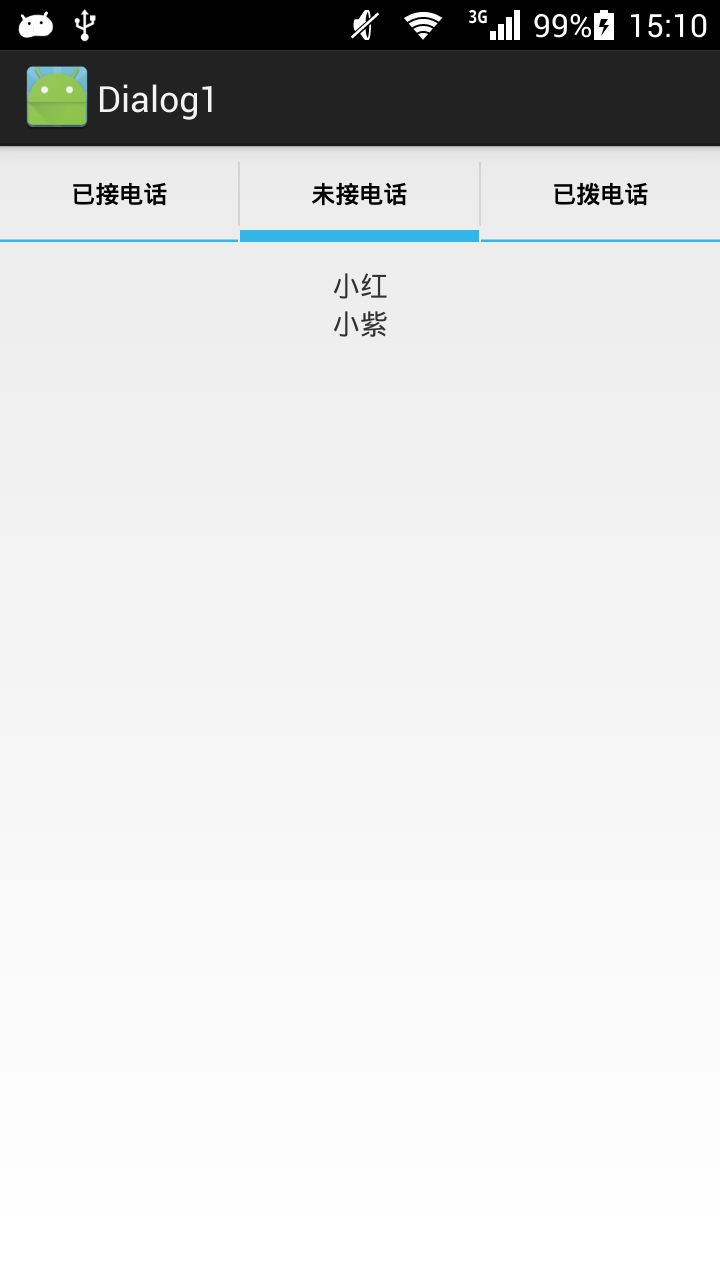12.Android之Tabhost组件学习
TabHost是整个Tab的容器,TabHost的实现有两种方式:
第一种继承TabActivity,从TabActivity中用getTabHost()方法获取TabHost。各个Tab中的内容在布局文件中定义就行了。
第二种方式,不继承TabActivity,在布局文件中定义TabHost即可,但是TabWidget的id必须是@android:id/tabs,FrameLayout的id必须是@android:id/tabcontent。
1)继承TabActivity
如果加载该TabHost画面的类继承TabActivity,并且想通过getTabHost()方法来获取TabHost,getTabWidget()方法获取TabWidget,那么TabHost、TabWidget 、FrameLayout 三者的ID必须是android.R.id.tabhost、android.R.id.tabs、android.R.id.tabcontent, 否则会报运行时异常, 比如提示Your content must have a TabHost whose id attribute is 'android.R.id.tabhost'之类错误
修改主布局activity_main文件:
<?xml version="1.0" encoding="utf-8"?>
<TabHost
xmlns:android="http://schemas.android.com/apk/res/android"
android:id="@android:id/tabhost"
android:layout_width="fill_parent"
android:layout_height="fill_parent"
android:background="@drawable/back"> <LinearLayout
android:orientation="vertical"
android:layout_width="fill_parent"
android:layout_height="fill_parent"> <TabWidget
android:id="@android:id/tabs"
android:layout_alignParentBottom="true"
android:layout_width="fill_parent"
android:layout_height="wrap_content"/>
<FrameLayout
android:id="@android:id/tabcontent"
android:layout_weight="1"
android:layout_width="fill_parent"
android:layout_height="fill_parent" /> </LinearLayout> </TabHost>
再增加自己定义的子TabHost页面布局文件tabhost1如下:
<?xml version="1.0" encoding="utf-8"?>
<TabHost
xmlns:android="http://schemas.android.com/apk/res/android"
android:id="@+id/mytabhost"
android:layout_width="match_parent"
android:layout_height="match_parent"> <LinearLayout
android:id="@+id/tab01"
android:layout_width="match_parent"
android:layout_height="match_parent"
android:orientation="vertical"> <TextView
android:layout_width="wrap_content"
android:layout_height="wrap_content"
android:text="小明"/> <TextView
android:layout_width="wrap_content"
android:layout_height="wrap_content"
android:text="小东"/> </LinearLayout> <LinearLayout
android:id="@+id/tab02"
android:layout_width="match_parent"
android:layout_height="match_parent"
android:orientation="vertical"> <TextView
android:layout_width="wrap_content"
android:layout_height="wrap_content"
android:text="小红"/> <TextView
android:layout_width="wrap_content"
android:layout_height="wrap_content"
android:text="小紫"/> </LinearLayout> <LinearLayout
android:id="@+id/tab03"
android:layout_width="match_parent"
android:layout_height="match_parent"
android:orientation="vertical"> <TextView
android:layout_width="wrap_content"
android:layout_height="wrap_content"
android:text="小李"/> <TextView
android:layout_width="wrap_content"
android:layout_height="wrap_content"
android:text="小北"/> </LinearLayout> </TabHost>
最后修改下MainActivity.java代码:
package com.example.administrator.dialog1; import android.os.Bundle;
import android.app.TabActivity;
import android.view.LayoutInflater;
import android.widget.TabHost; public class MainActivity extends TabActivity { TabHost mtabHost = null;
@Override
protected void onCreate(Bundle savedInstanceState) {
super.onCreate(savedInstanceState);
setContentView(R.layout.activity_main); //调用TabActivity的getTabHost()方法获取TabHost对象
mtabHost = this.getTabHost(); //设置使用TabHost布局
LayoutInflater.from(this).inflate(R.layout.tabhost1, mtabHost.getTabContentView(),true); //添加第一个标签页
mtabHost.addTab(mtabHost.newTabSpec("tab01").setIndicator("已接电话").setContent(R.id.tab01)); //添加第二个标签页,并在其标签上添加一个图片
mtabHost.addTab(mtabHost.newTabSpec("tab02").setIndicator("未接电话",getResources().getDrawable(R.mipmap.ic_launcher)).setContent(R.id.tab02)); //添加第三个标签页
mtabHost.addTab(mtabHost.newTabSpec("tab03").setIndicator("已拨电话").setContent(R.id.tab03)); } }
运行效果:

2) 不继承TabActivity
修改MainActivity.java代码:
package com.example.administrator.dialog1; import android.app.Activity;
import android.os.Bundle;
import android.widget.TabHost;
import android.widget.TabWidget; public class MainActivity extends Activity { TabHost mtabHost = null;
TabWidget tabWidget = null;
@Override
protected void onCreate(Bundle savedInstanceState) {
super.onCreate(savedInstanceState);
setContentView(R.layout.tabhost1); //以下三句代码,注意顺序
mtabHost = (TabHost)findViewById(R.id.mytabhost);
mtabHost.setup();
tabWidget = mtabHost.getTabWidget(); //添加第一个标签页
mtabHost.addTab(mtabHost.newTabSpec("tab01").setIndicator("已接电话").setContent(R.id.tab01)); //添加第二个标签页,并在其标签上添加一个图片
mtabHost.addTab(mtabHost.newTabSpec("tab02").setIndicator("未接电话",getResources().getDrawable(R.mipmap.ic_launcher)).setContent(R.id.tab02)); //添加第三个标签页
mtabHost.addTab(mtabHost.newTabSpec("tab03").setIndicator("已拨电话").setContent(R.id.tab03)); mtabHost.setCurrentTab(0);
} }
再修改下tabhost1布局文件:
<?xml version="1.0" encoding="utf-8"?>
<TabHost
xmlns:android="http://schemas.android.com/apk/res/android"
android:id="@+id/mytabhost"
android:layout_width="match_parent"
android:layout_height="match_parent"> <TabWidget
android:id="@android:id/tabs"
android:layout_width="fill_parent"
android:layout_height="wrap_content"/> <FrameLayout
android:id="@android:id/tabcontent"
android:layout_weight="1"
android:layout_width="fill_parent"
android:layout_height="fill_parent" > <LinearLayout
android:id="@+id/tab01"
android:layout_width="match_parent"
android:layout_height="match_parent"
android:orientation="vertical"> <TextView
android:layout_width="wrap_content"
android:layout_height="wrap_content"
android:layout_marginTop="60dp"
android:text="小明"/> <TextView
android:layout_width="wrap_content"
android:layout_height="wrap_content"
android:layout_marginBottom="60dp"
android:text="小东"/> </LinearLayout> <LinearLayout
android:id="@+id/tab02"
android:layout_width="match_parent"
android:layout_height="match_parent"
android:orientation="vertical"> <TextView
android:layout_width="match_parent"
android:layout_height="wrap_content"
android:gravity="center"
android:layout_marginTop="60dp"
android:text="小红"/> <TextView
android:layout_width="match_parent"
android:layout_height="wrap_content"
android:gravity="center"
android:layout_marginBottom="60dp"
android:text="小紫"/> </LinearLayout> <LinearLayout
android:id="@+id/tab03"
android:layout_width="match_parent"
android:layout_height="match_parent"
android:orientation="vertical"> <TextView
android:layout_width="match_parent"
android:layout_height="wrap_content"
android:gravity="right"
android:layout_marginTop="60dp"
android:text="小李"/> <TextView
android:layout_width="match_parent"
android:layout_height="wrap_content"
android:gravity="right"
android:layout_marginBottom="60dp"
android:text="小北"/> </LinearLayout> </FrameLayout> </TabHost>
最终运行效果:

12.Android之Tabhost组件学习的更多相关文章
- Android的TabHost组件-android的学习之旅(四十)
TabHost简介 虽然,官方建议用Fagment取代TabHost,但是我们还是大概的介绍一下.TabHost是一种非常简单的组件,TabHost可以很方便的在窗口放置多个标签页,每一个标签页相当于 ...
- Android之EditText组件学习
一.基础学习 1.Button是TextView的一个子类,所以按钮本身是一个特殊的文本,属性和TextView相似 2.EditText类似html里的input type="text&q ...
- Android之TextView组件学习
一.基础学习 1.findViewById返回View类,该类是所有View组件的父类. 2.子类比父类拥有更多的属性和方法,不过子类找不到的话去父类找 3.marquee:华盖,跑马灯效果:orie ...
- Android的四大组件学习
一.Linearlayout : 线性布局 1. android:orientation="vertical" //控件的方向控制,vertical : 垂直布局 , ...
- 从零開始学android<TabHost标签组件.二十九.>
TabHost主要特点是能够在一个窗体中显示多组标签栏的内容,在Android系统之中每一个标签栏就称为一个Tab.而包括这多个标签栏的容器就将其称为TabHost.TabHost类的继承结构例如以下 ...
- Android应用程序组件Content Provider简要介绍和学习计划
文章转载至CSDN社区罗升阳的安卓之旅,原文地址:http://blog.csdn.net/luoshengyang/article/details/6946067 在Android系统中,Conte ...
- Android之TabHost布局(转)
1.概念 盛放Tab的容器就是TabHost.TabHost的实现有两种方式: 第一种继承TabActivity,从TabActivity中用getTabHost()方法获取TabHost.各个Tab ...
- 转-TabHost组件(一)(实现底部菜单导航)
http://www.cnblogs.com/lichenwei/p/3974009.html 什么是TabHost? TabHost组件的主要功能是可以进行应用程序分类管理,例如:在用户使用wind ...
- 转-TabHost组件(二)(实现底部菜单导航)
http://www.cnblogs.com/lichenwei/p/3975095.html 上面文章<安卓开发复习笔记——TabHost组件(一)(实现底部菜单导航)>中提到了利用自定 ...
随机推荐
- android app多渠道分发打包
1. 美团多渠道包的方法论 1) maven编译多次 2) apktool一次包,解开重新打 (个人倾向于这个) 3) http://tech.meituan.com/mt-apk-packagi ...
- 关于软件测试人员能力模型的建立(from知乎)
转自: http://www.zhihu.com/question/20254092 测试思维方面:1.测试基础理论(测试流程.测试的基础知识)2.测试用例设计方法论(黑盒.白盒)3.软件质量体系(建 ...
- ZIP文件伪加密
题目给出图片,那当然是从图片下手啦! 首先下载图片,在Linux系统下用binwalk工具打开,果然不出所料,里面藏有文件! 用dd把它分解出来! 'txt' 格式的文件提取出来!会看到一个Zip压缩 ...
- Android 手势识别类 ( 三 ) GestureDetector 源码浅析
前言:上 篇介绍了提供手势绘制的视图平台GestureOverlayView,但是在视图平台上绘制出的手势,是需要存储以及在必要的利用时加载取出手势.所 以,用户绘制出的一个完整的手势是需要一定的代码 ...
- 使用EXISTS语句注意点
1.使用EXISTS语句,其目标列一般用“*”,因为带EXISTS的子查询只返回真值或假值,给出列名无实际意义. 2.使用EXISTS语句一定要注意上下两个表之间要建立联系. 例如,查询所有选修了1号 ...
- 后台首页品字形(frameset)框架搭建
get_defined_constants([true])//显示所有常量信息.参数true,表示分组显示,查看当前系统给我提供了哪些常量可以使用,包括自定义常量. __CONTROLLER__//获 ...
- treepanel加滚动条
- Studying-Swift :Day01
学习地址:http://www.rm5u.com/ 或 http://www.runoob.com/ 如果创建的是 OS X playground 需要引入 Cocoa; 如果我们想创建 ...
- [资源]PHP使用消息队列
利用PHP操作Linux消息队列完成进程间通信 基于HTTP协议的轻量级开源简单队列服务:HTTPSQS[原创] Redis队列——PHP操作简单示例 入队操作 <?php $redis = n ...
- ibatis动态查询条件
ibatis的调试相对困难,出错的时候主要依据是log4生成的log文件和出错提示,这方面要能比较熟练的看懂. 下面这个配置基本上包含了最复杂的功能:分页\搜索\排序\缓存\传值Hash表\返回has ...
